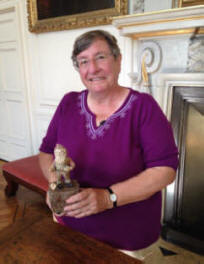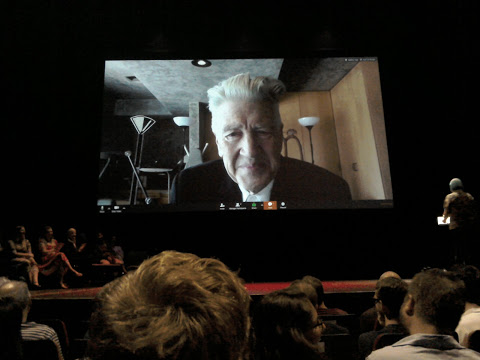I’ll not lie, Christine Walkden is my favourite TV gardener. I’ve been watching her since 2006 when she first appeared on our screens in Christine’s Garden. Since then, she has been a fixture on gardening programmes including Gardeners’ World, Glorious Gardens from Above and the Great British Garden Revival, to name but a few. These days she’s also The One Show’s resident garden guru. She is knowledgeable, likeable and accessible, and I knew I’d enjoy having a right good chat with her. But even better than that, she’s Northern. Originally from Rishton near Blackburn, Walkden retains the lovely rolling timbre of her Lancashire accent and has a uniquely Northern no-nonsense approach to gardening.
I’m interested in what sparked this lifelong enthusiasm for growing. Walkden recalls first being interested in plants at junior school “where at backend [Autumn], the teachers used to bring us a crocus each and we had to pot it up and look after it”. This spark eventually led to her owning her own allotment, aged just 11.
“As a kid you don’t realise that’s a bit odd. I wanted to grow, and we didn’t have a garden at the house.” Rather than odd, it seems astonishing. It would never have occurred to me to do the same thing at such a tender age. But it’s obvious that, to Walkden, the urge to grow things was as natural as breathing.
Given that her TV presenting is equally natural, I wonder if it came easily to her? “No,” she says, with a laugh. “No, it did not. It was a lot of hard work. You can be natural and personable in person but it’s very different with a camera stuffed in your mush. I’m OK with interviews and doings things. I try to be as natural as possible but it’s basically pieces to camera I struggle with because it’s not my words. I’m not an actress and it’s like getting blood out of a stone.”
So, how does she cope with the fame? “What do you mean by fame? Fame is somebody recognising you. And so what? All that happens is sometimes people come up to me and say, ‘I like you on the telly’, which is quite nice, actually. But I’ve never got why people want to be famous.”
She adds: “I’ve just been down to the bank this morning and a local school was taking the kiddywinkles on a walk around. The teacher asked if I minded being introduced to them. I said they won’t know me, so he introduces me and says, ‘this is Christine Walkden, do any of you recognise her off the television?’ Of course, not a single one of them did.’” She chuckles again. “So that’s fame. When you’ve 60 kids who don’t recognise you.” 
Walkden is appealing because she is so down to earth. As a Lancastrian with loads of experience gardening in this part of the world, I’m curious what advice she has for Northern gardeners.
“Go with the seasons, don’t fight it. Don’t put things in too early and be prepared to lose things quite early at the backend. Go with what you’ve got rather than fighting it. If it’s freezing cold outside and you’re not going out, what are you putting a baby plant out for? It’s a life.”
She also suggests growing hardy plants, which seems very sensible advice. While we are on the subject, and being cheeky, I take the opportunity to pick Walkden’s brains about what to grow on the damp, clay, dark side of my garden. “Ferns, hostas, heucheras, tiarellas, they’d all do. And, depending on how dark it is, astrantias.”
My route to gardening came about through herbalism, and cultivating native plant species has helped me to understand how they support wildlife. So, if gardeners are trying to encourage wildlife into their green spaces, what should they grow?
“It’s more a case of what you don’t do,” advises Walkden. “Don’t use hybrids and don’t use double or fancy flowers whether it’s a bulb, a tree, a shrub or whatever. So, keep to single, simple flowering things such as double hellebores and peony flowered hellebore. All this stuff that’s been bred to produce fancy flowers are a nightmare for insects and pollination. All those fancies are a dead loss as they are so bred, they don’t produce enough nectar. In fact, some of them are sterile, so they do bugger all for anything other than for man’s satisfaction.”
Talking of satisfaction, I share my healthy obsession for roses and can’t resist finding out her favourite. “William Lobb,” she reveals. “It’s an old English shrub rose. It’s purple and the fragrance is out of this world.”
We both hold the view that a rose without scent has little point. “Why do you have anything that doesn’t smell? What’s a carnation unless it whiffs? You have a beautiful bouquet at a wedding with no scent, what’s that about? Again, that’s to do with breeding.”
I’m growing Paul’s Himalayan Musk along our back fence, mainly because its perfume is so divine. “That’s a good smelly,” agrees Walkden. “You’ll need a big fence, though. They can get to 90 ft, happy fighting.” Despite initial fears it would struggle with our soil, it’s already grown rapidly, but, according to Walkden, roses love our heavy Northern soil.
 With a climate crisis looming, does Walkden believe we can make a difference with what we grow in our gardens?
With a climate crisis looming, does Walkden believe we can make a difference with what we grow in our gardens?
“Yes, I think if you look at sustainable planting, reduced peat and reduced plastics, every single one of us in our own way can do a little bit. Using a recyclable taupe plant pot instead of a black plastic plant pot is going to make a difference overall. There’s over 60 million people in this country. If we all reduced our use of plastic pots, we’d be better off.
“I’m not against using plastic, but I’m very against single use plastic. I’ve got my original plant pots and seed trays that I bought when I was 11-years-old and I’m still using them. I have not bought a seed tray or plant pot since I started. Now that is ultimate recycling.”
I’m surprised by this but, when I think about it, almost all my seed trays and pots were given to me and I have repaid the favour by passing on extra pots to friends and neighbours.
“We can recycle all sorts of things, but we are a throwaway society. People have lost the plot. In the old days, we used to wrap plants up in newspaper. They’d be grown in wooden seed trays. Bedding plants would be pulled apart and you could buy six or 12. They’d be wrapped in paper and you’d take them home.”
 So, why we don’t do that now? “Because of handling and cost and all that claptrap. And nasty newsprint and health and safety, and you might just get a splinter and oh my dear. It’s a crazy world we live in.”
So, why we don’t do that now? “Because of handling and cost and all that claptrap. And nasty newsprint and health and safety, and you might just get a splinter and oh my dear. It’s a crazy world we live in.”
It’s difficult to disagree. We’ve become so far removed from the natural world. Does Walkden think this is part of the problem?
“A few years ago, at the Llangollen Garden Show, we asked school kids to identify normal vegetables. A lot of them hadn’t got a clue and these were things like carrots, lettuce and peas. So, what does that tell you? That’s where we are. The difficulty is getting people interested. How do you instil a love and passion and the belief that plants are important?
“I ask people to imagine what would be left if there was no green in the world. Bugger all, and that’s what a plant does. In the old days, we used to have nature tables and the teachers used to take us out into the countryside. We were introduced to the flowers and trees around us, we grew plants at school. Our parents would make daisy chains with us and put buttercups under our chins, and it connected us to nature.
“What’s very sad now is the way we educate kids through computers, they don’t know how to look and find out. You can’t Google a robin if you don’t know what it’s called and there lies another tale. The world’s gone crazy – put your head in a load of compost and enjoy it.”
To be honest, that sounds like good advice to me and, as a parting pearl of wisdom, Walkden says: “Don’t give up with gardening if it isn’t successful first time. You didn’t learn to drive after one lesson, so don’t expect to instantly be able to grow. If it doesn’t work the first time, learn, try again and think about what you’ve done wrong.
 “Growing plants is remarkably like growing people, they need food and water and they need it regularly. You wouldn’t put a baby out in the freezing cold or baking heat, so don’t do it to your baby plants. It’s common sense. Do to it what you would do to yourself.”
“Growing plants is remarkably like growing people, they need food and water and they need it regularly. You wouldn’t put a baby out in the freezing cold or baking heat, so don’t do it to your baby plants. It’s common sense. Do to it what you would do to yourself.”
It’s been a dream come true and enormous fun talking to Walkden. Before she goes, I ask what 2020 has in store for her? “More excitement as far as growing is concerned, more travelling, more lectures, more doing everything I always do.”
I tell her I think she has a fascinating life. “I’ve done alright,” she says, which might just be the understatement of the year.
By Claire Fleetneedle, Gardening Correspondent
Images courtesy of Christine Walkden. Main image by Claire Fleetneedle.











